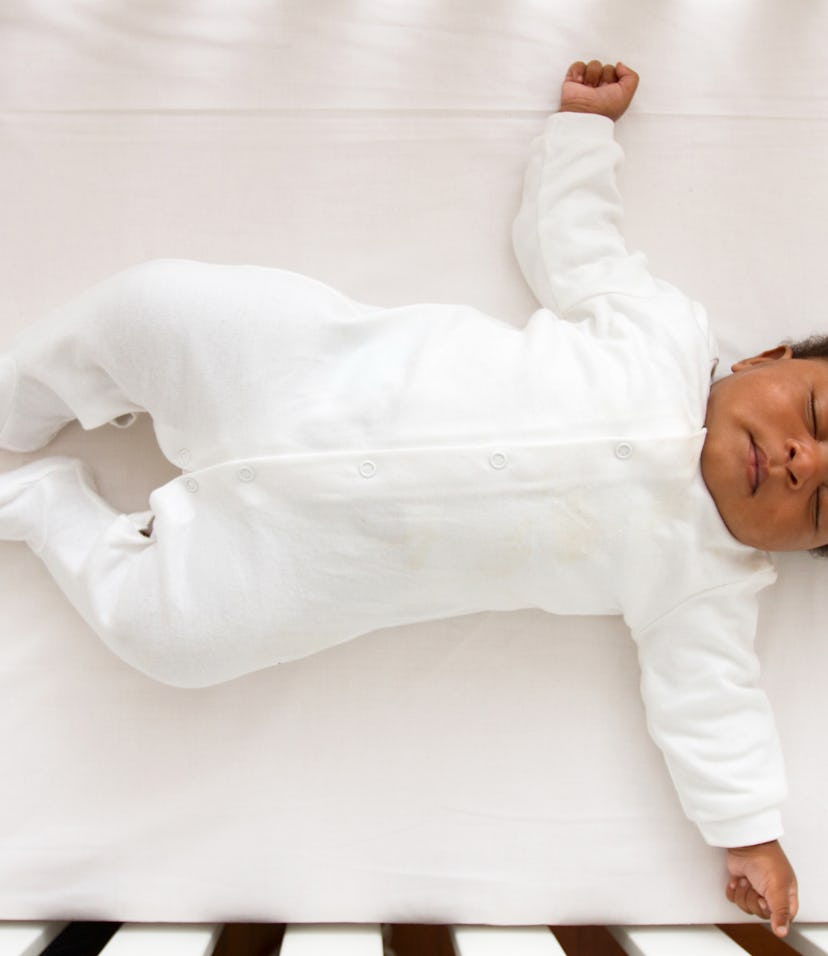Sleep

How To Dress Your Baby For Sleep, Because You're Totally Clueless
For a safe and restful night.
When it comes to babies and sleep, caregivers' top concerns are typically: how to keep them safe and how to get them to sleep through the night. As it turns out, knowing how to dress your baby for sleep is important for both. Not to mention, it’s much easier for you to get restful sleep when you’re confident your baby is safely doing the same (even if it's happening in three-hour increments).
What Should Infants Wear For Sleep?
In their first few months of life (until they are about two to four months old), infants’ needs are a bit different, which means how you dress your baby for sleep during this time is slightly different as well. In an email to Romper, postpartum doula Tracy M. Crockett, CPD, CNC, IFS, explains that caregivers should carefully choose both pajamas and swaddles for infants. “Breathable newborn baby pajamas made from materials such as cotton, bamboo, or muslin can be used along with a swaddle” during the first couple of months. The breathable fabrics and the compression of the swaddle will work together to keep your infant cozy enough to get quality sleep.
As for ensuring your baby is safe, make sure that whatever pajamas you choose, whether it’s footies, separate pieces, or a romper of some sort, have a snug fit. This shouldn’t be too difficult, as baby pajamas should be made to fit snug anyway, but you will need to make sure you’re getting the correct size for your baby (just because they’re a newborn doesn’t mean newborn sizing is right for them). Additionally, “embellishments and fasteners that can come loose, such as buttons or pacifier clips, should never be used in a sleep space,” says Crockett. As for swaddles, caregivers should know how to swaddle correctly to ensure safety. Crockett explains that a proper swaddle will “allow for movement without excess material gathering around the face.” Finally, it’s important to know when to stop swaddling, too. “Babies should not be swaddled past four months [old],” pediatrician Dyan Hes, MD, tells Romper in an email, “because this can delay the milestones of rolling over.”
The Best Sleepwear For Babies
Once your baby has either reached the maximum swaddling age or they’ve mastered breaking free from the wrap, you can transition them to a sleep sack/wearable blanket. “Babies should never have any loose blankets in the crib,” Dr. Hes stresses, “They are a risk for strangulation.” Still, she notes that, since babies often benefit from an extra layer of fabric over their pajamas, wearable blankets are an excellent choice.
As far as pajamas go, both Dr. Hes and Crockett say the same guidelines apply whether the baby is a newborn or approaching 12 months old. They should be snug, made from breathable fabric, and free of anything that can pop off and become a choking or strangulation hazard. Also, once your child starts wearing 9M size pajamas, they are subject to the Consumer Product Safety Commission standards which include a tight fit and made from fabric(s) that pass flammability tests.
Keeping Baby Warm At Night
Dr. Hes and Crockett both agree that a very important factor in how to dress your baby for sleep so that they are safe and comfortable has less to do with specific pajama, sleep sack, or swaddle styles, and more to do with the baby’s temperature throughout the night. “The suggested year-round room temperature to reduce the risk of overheating or SIDS is 68-72 degrees,” says Crockett, so caregivers’ focus should really be on trying to keep their baby’s nursery as close to that temperature range as possible.
Of course, depending on where the baby’s room is located this may be easier said than done, like if the nursery is next to an attic or over a garage, for example. In the warmer months, Dr. Hes suggests sticking to sleep sacks made from cotton but then considering one made from fleece in the colder months. “If the room is drafty or cold a child can wear a soft cotton hat,” she adds, “Remember babies lose most of their body heat from their head because it takes up a large percentage of their body surface area.”
Regardless of the time of year, parents should always pay close attention to the temperature in the baby’s room to ensure they’re not at risk of overheating. “Do not overdress your baby,” says Dr. Hes, “Overheating a baby... increases risk for sudden infant death syndrome.” To test their temperature, Crockett advises caregivers to gently touch the baby’s neck or upper back while they’re sleeping. “If they feel hot, clammy, or sweaty, they are too hot and a layer should be removed,” she says.
Overall, by knowing how to dress your baby for sleep in a safe way you’re also knowing how to dress them for a comfortable, restful night of sleep. Remember, the three things to focus on are: breathable fabrics, an age-appropriate extra layer, and temperature control.
We only include products that have been independently selected by Romper's editorial team. However, we may receive a portion of sales if you purchase a product through a link in this article.
Experts:
Tracy M. Crockett CPD, CNC, IFS, Owner & Founder of Sweet Dreams Doula
Dyan Hes, MD, Founder & Medical Director of Gramercy Pediatrics